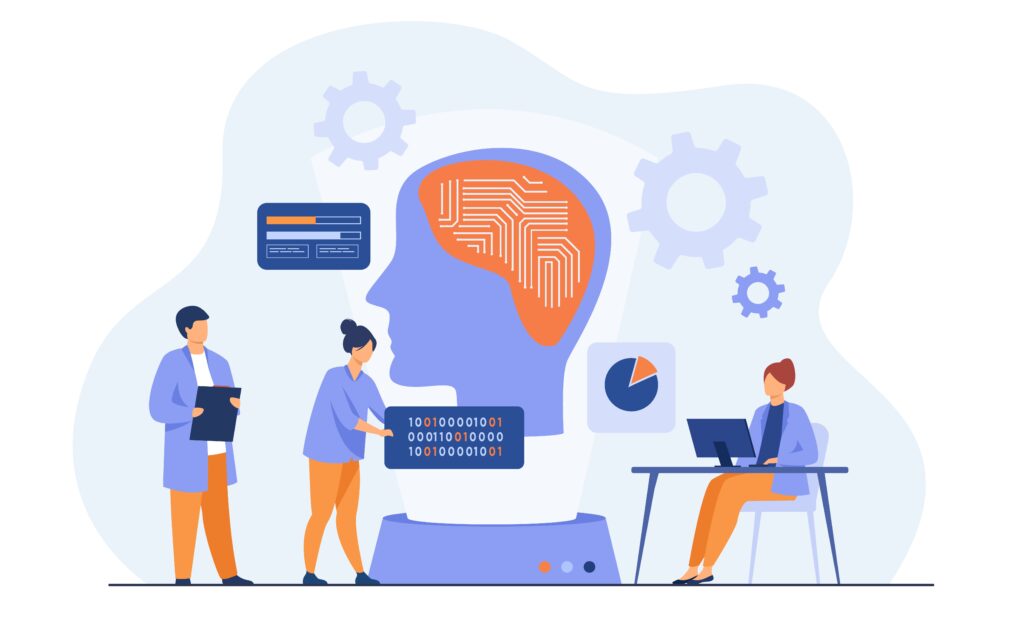Artificial Intelligence (AI) has become one of the most discussed, debated, and evolving fields in technology today. But what exactly is AI? How did it come about, and how does it actually work? Whether you’re an expert in the field or just starting to explore, understanding the basics, types, and future of AI is essential to grasping its growing impact on society. Let’s dive into the world of artificial intelligence, break it down in simple terms, and explore what technology is, along with the unique insights surrounding this fascinating field.
What is Artificial Intelligence (AI) Technology?
Artificial Intelligence, or AI, is essentially the creation of computer systems or machines that can perform tasks typically requiring human intelligence. This includes recognizing speech, making decisions, solving problems, and even understanding language. Think of AI as teaching a machine to think, learn, and adapt the way a human would—but with a digital brain.
When you interact with AI, such as when you ask Siri for directions or get movie recommendations on Netflix, the technology behind the scenes is working tirelessly to process and analyze data, providing you with the best possible answers or suggestions. In essence, AI allows machines to mimic human behavior, continuously improving themselves as they learn from more data.
What’s fascinating about AI is that it’s not just one single technology. It’s a collection of technologies, algorithms, and computational systems that work together to bring machines closer to human intelligence. AI is categorized by its capacity for reasoning, learning, and decision-making, enabling it to perform tasks across different industries—from healthcare to entertainment and beyond.
But where did this all start? How did we get from the basic calculators of the past to machines that can now beat grandmasters at chess and compose music?
Artificial Intelligence History
The concept of machines that think isn’t new. In fact, you could trace the roots of AI back to ancient myths, where inventors dreamed of creating beings capable of understanding and performing human tasks. However, the actual scientific groundwork for AI began in the mid-20th century.
- Early Beginnings
The first notable step towards AI happened in 1950 when mathematician Alan Turing asked, “Can machines think?” This question led to what we now know as the Turing Test, a benchmark for whether a machine’s behavior is indistinguishable from a human’s. If a machine could fool a person into thinking it was human, it would be said to have intelligence. - The Birth of AI
In 1956, the field of AI was officially born during a summer conference at Dartmouth College. Researchers, including John McCarthy (who coined the term “artificial intelligence”), Marvin Minsky, and others, proposed that human reasoning could be replicated by machines. Although the expectations were high, progress was slow due to technological limitations. - AI Winters
Over the following decades, AI experienced several “winters,” periods of decreased funding and interest. Early AI systems lacked the computing power needed to process the vast amounts of data required for tasks like image recognition or natural language understanding. - Rise of Machine Learning
The resurgence of AI came with the development of machine learning in the 1980s and 1990s. Machine learning allows computers to analyze large datasets, spot patterns, and make predictions without being explicitly programmed for each specific task. This was the breakthrough that finally set AI on a path toward becoming the indispensable tool it is today. - Modern AI
Fast forward to the 21st century, and AI is everywhere. With advances in computing power, cloud technologies, and access to vast amounts of data, AI can now do things that were once considered science fiction. From self-driving cars to virtual assistants, AI has infiltrated every corner of our lives.
How Does Artificial Intelligence Work?
You might be wondering, “How does AI actually function behind the scenes?” Well, it’s simpler than it sounds, even though it can be complex under the hood. AI works by using algorithms—essentially sets of rules or instructions—that tell a machine how to perform a task.
Here’s a basic breakdown of how AI systems generally operate:
- Data Input
AI systems need data to learn. This could be text, images, audio, or any kind of information that the system can process. For example, if you’re teaching an AI to recognize cats, you feed it thousands of pictures of cats. - Learning from Data
AI uses a process called machine learning, where it analyzes the data to recognize patterns and make decisions. This is where the “learning” part comes in—AI doesn’t just memorize the input data but generalizes it to make predictions on new, unseen data. - Training the Model
During training, the AI adjusts its internal parameters based on the input data. This is similar to how your brain strengthens neural pathways when you learn something new. Once trained, the AI model can make accurate predictions or decisions based on new information. - Making Predictions or Decisions
Once trained, the AI model can analyze new data and make decisions in real time. For example, AI in healthcare might look at an X-ray and predict the likelihood of a patient having a certain condition. - Improving Through Feedback
AI is not static. It improves through feedback. The more data it processes and the more feedback it receives, the better it gets at its tasks. This is one reason why AI is advancing so rapidly today—it can continually improve as it learns.
While the underlying mathematics and algorithms are complex, the core concept is simple: feed data to the machine, teach it to recognize patterns, and let it learn over time. But, like anything powerful, AI has its strengths and weaknesses.
Advantages and Disadvantages of AI
AI comes with a host of benefits, but it’s not without its challenges. Understanding the pros and cons can help you navigate where AI might be a game-changer and where it still needs improvement.
Advantages of AI:
- Efficiency and Automation
AI excels in automating repetitive tasks that would otherwise take humans a lot of time. Whether it’s processing paperwork or scanning large datasets, AI can get the job done faster and more accurately. - Data Analysis
With its ability to analyze vast amounts of data in real-time, AI can find patterns and make predictions that would be impossible for humans to detect. This is why AI is a vital tool in industries like finance, healthcare, and marketing. - Personalization
AI allows businesses to offer highly personalized services. Ever wondered how Netflix always seems to know what you want to watch next? That’s AI working to understand your preferences and make accurate recommendations. - Around-the-Clock Operation
Machines don’t need sleep. AI can work 24/7, meaning businesses can run operations continuously without the need for breaks or rest.
Disadvantages of AI:
- Lack of Creativity and Emotions
While AI can process information and make decisions, it lacks the ability to think creatively or understand emotions. Human intuition, creativity, and emotional intelligence are still beyond the grasp of machines. - Job Displacement
As AI takes over more tasks, there are growing concerns about job displacement. Certain roles, particularly those involving repetitive tasks, may become obsolete, creating challenges in the job market. - Ethical Concerns
With great power comes great responsibility, and AI is no exception. From privacy issues to the ethical dilemmas of autonomous weapons, AI brings with it a host of ethical questions that society must address. - Bias in Decision-Making
AI is only as good as the data it’s trained on. If the data is biased, AI can make decisions that are equally biased, leading to unintended consequences in areas like hiring, law enforcement, and finance.
With this balanced understanding of AI’s potential and its limitations, it’s time to explore the different types of AI.
Types of Artificial Intelligence
AI is often categorized into different types based on its capabilities. Let’s break them down so you can get a clearer idea of where current AI stands and where it’s headed.
1. Reactive Machines
This is the most basic type of AI, designed to perform specific tasks. It doesn’t have memory or the ability to use past experiences to inform future actions. A classic example is IBM’s Deep Blue, the chess-playing computer that beat Garry Kasparov in 1997. While Deep Blue could analyze the chessboard and make the best possible move, it didn’t learn from past games or adapt.
2. Limited Memory AI
Most AI systems you interact with today fall into this category. Limited memory AI can use past data to inform future decisions, but its memory is still constrained. For instance, self-driving cars use this type of AI to observe traffic patterns and adjust their driving accordingly.
3. Theory of Mind AI
While still in the research phase, the theory of mind AI refers to machines that can understand emotions, thoughts, and social interactions. This would allow AI to interact more naturally with humans, adapting to social cues and emotional contexts.
4. Self-Aware AI
The ultimate form of AI—though we haven’t reached this level yet—is self-aware AI. This would be a machine that has consciousness, self-awareness, and the ability to think independently. While this remains science fiction for now, the prospect of self-aware AI raises numerous ethical and philosophical questions.
Understanding these categories helps you see how AI is developing and where we might be heading in the future.
Future of AI
When you think about the future of AI, it’s easy to imagine a world filled with robots, smart machines, and automated systems. But what’s the reality? While we’re still far from a fully autonomous world, AI’s potential is massive.
1. AI in Healthcare
AI’s role in healthcare is rapidly expanding. From diagnosing diseases to personalizing treatment plans, AI is revolutionizing how medical professionals approach patient care. Imagine a world where AI can detect diseases earlier than humans, predict potential outbreaks, or even create personalized medications based on your genetic makeup. While AI in healthcare still requires human oversight, its ability to process massive datasets and spot patterns that might elude even the most trained doctors is already saving lives.
2. AI in Transportation
Self-driving cars are often seen as the future of transportation, but AI’s potential goes beyond that. AI could help optimize traffic flows in smart cities, reducing congestion and emissions. It could improve safety in air travel or revolutionize logistics by enabling fully autonomous trucks to transport goods across countries. The future of transportation, powered by AI, promises more efficiency, safety, and sustainability.
3. AI in Education
In education, AI can offer personalized learning experiences that adapt to individual students’ needs and learning styles. Imagine an AI tutor that knows exactly where you’re struggling in a subject and tailors lessons accordingly, helping you understand complex topics faster. AI can also help teachers by automating administrative tasks, allowing them to focus more on teaching.
4. AI and Creativity
We often think of creativity as uniquely human, but AI is increasingly playing a role in creative industries. AI-generated art, music, and even writing are becoming more common. While AI might not yet replace human creativity, it can assist artists and creators in producing new forms of content or offering inspiration.
5. AI in Everyday Life
AI will continue to integrate into your daily life in more seamless ways. Virtual assistants will become smarter, homes will become more automated, and even tasks like grocery shopping or managing your finances will be AI-driven. The aim is to make everyday life more convenient, giving you more time to focus on what truly matters.
6. Ethical and Legal Challenges in the Future of AI
While the possibilities of AI seem endless, they also raise significant ethical and legal questions. As AI continues to develop, there will be increased scrutiny over issues like data privacy, algorithmic fairness, and the potential for AI systems to make decisions that have far-reaching consequences. For example, how do we ensure that AI used in hiring or law enforcement doesn’t perpetuate bias? What legal frameworks need to be in place to govern AI’s role in autonomous weaponry or surveillance?
The future of AI is bright, but it’s essential to consider these ethical challenges as we move forward, ensuring that AI is developed responsibly and with the best interests of humanity in mind.
Conclusion
Artificial Intelligence is no longer a futuristic concept—it’s a reality that’s shaping the way we live, work, and interact with the world. From its roots in early computing to the present-day advancements in machine learning and beyond, AI’s journey has been nothing short of extraordinary. As you’ve seen, AI is making waves in nearly every industry, offering unparalleled efficiency, insights, and innovations. But it’s not without its challenges.
As we look toward the future, the key to unlocking AI’s full potential will be how we manage its growth, ensuring that it benefits society as a whole. Whether you’re an expert or just a curious enthusiast, understanding AI’s capabilities, limitations, and future direction will prepare you to navigate the ever-changing technological landscape.
The exciting part? We’re just scratching the surface. AI’s future promises to be even more transformative, bringing with it opportunities, innovations, and challenges that will redefine our world. So, buckle up—because the future of AI is one journey you won’t want to miss!
FAQs About Artificial Intelligence
As AI becomes more ingrained in our world, it’s natural to have questions about its capabilities, limitations, and future. Let’s explore some of the most common questions people have about AI.
AI will inevitably replace some jobs, particularly those that involve repetitive, routine tasks. However, it’s also expected to create new jobs that focus on higher-level decision-making, creativity, and problem-solving. The key to staying relevant in an AI-driven world is to adapt and learn new skills that complement AI technologies continually.
AI, like any powerful technology, has the potential to be dangerous if misused. For instance, AI in the wrong hands could be used for malicious purposes, such as cyberattacks or autonomous weapons. However, with the right regulations and ethical frameworks, these risks can be minimized.
AI is incredibly powerful when it comes to specific tasks like recognizing images, translating languages, or playing complex games like Go. However, general AI—the type of AI that can think and reason like humans across a broad range of activities—doesn’t yet exist. Most AI today is still narrow AI, designed to excel in specific areas.
AI learns through a process known as machine learning. It analyzes data, identifies patterns, and makes predictions based on those patterns. There are different types of machine learning, including supervised learning, where AI is trained on labeled data, and unsupervised learning, where it tries to find patterns on its own.
AI is a broad field that aims to create machines capable of mimicking human intelligence. Machine learning is a subset of AI that focuses on teaching machines to learn from data. In essence, all machine learning is AI, but not all AI involves machine learning.
Despite its incredible capabilities, AI has limitations. They can’t think creatively, understand emotions, or reason like humans. AI also requires vast amounts of data to learn and is susceptible to bias if the data it’s trained on is biased.
This is a question that divides experts. Some believe that we’ll eventually achieve human-level or even superhuman-level AI, while others think that the complexities of human thought are too difficult to replicate in machines. Regardless of the answer, AI will continue to advance in remarkable ways.

The Chief Author and Editor at Intothecommerce. As a seasoned expert in digital marketing, I direct the site’s strategic content and ensure every piece meets the highest industry standards. My insights drive our coverage on SEO, paid media, and cutting-edge marketing technology.





